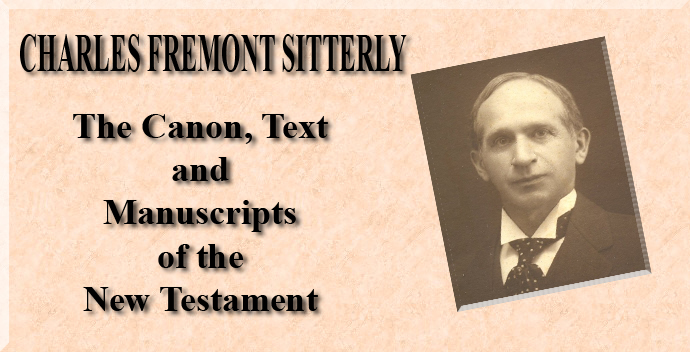
The Canon, Text, and Manuscripts of the New Testament
By Charles Fremont Sitterly
PART II - THE TEXT OF THE NEW TESTAMENT
Its sources, its errors, and the methods, history, and results of its criticism
Introduction
|
The literary evidence to the text of the New Testament is vastly more abundant than that to any other series of writings of like compass in the entire range of ancient letters. Of the sacred books of the Hebrew Bible there is no known copy antedating the tenth century of the Christian era. Of Homer there is no complete copy earlier than the thirteenth century. Of Herodotus there is no manuscript earlier than the tenth century. Of Virgil but one copy is earlier than the fourth century, and but a fragment of all Cicero's writings is even as old as this. Of the New Testament, however, we have two splendid manuscripts of the fourth century, ten of the fifth, twenty-five of the sixth, and in all a total of more than three thousand copies in whole or in part of the Greek New Testament. To these copies of the text itself may be added the very important and even more ancient evidence of the versions of the New Testament in the Latin, Syriac, and Egyptian tongues and the quotations and clear references to the New Testament readings found in the works of the early Church Fathers, as well as the inscriptions and monumental data in Syria, Asia Minor, Africa, Italy, and Greece, dating from the very age of the apostles and their immediate successors. It thus appears that the documents of the Christian faith are both so many and so widely' scattered that these very facts more than any others have embarrassed the final determination of the text. Now, however, the science of textual criticism has so far advanced, and the textual problems of the Greek Testament have been so largely traversed, that one may read the Christian writings with an assurance approximating certainty. Professor Eberhard Nestle speaks of the Greek text of the New Testament issued by Westcott and Hort as the "nearest in its approach to the goal." Professor Alexander Souter's edition with a select apparatus criticus of the revisers' Greek New Testament (Oxford, 1910) no doubt attains even a higher water mark. Let us trace as far as it can be done, in a clear and untechnical manner, the process of connection between the original writings and this, one of the latest editions of the Greek New Testament.
|
|
 |
 |
|
|
|
-
Site Navigation
 Home
Home What's New
What's New Bible
Bible Photos
Photos Hiking
Hiking E-Books
E-Books Genealogy
Genealogy Profile
Free Plug-ins You May Need
Profile
Free Plug-ins You May Need
 Get Java
Get Java.png) Get Flash
Get Flash Get 7-Zip
Get 7-Zip Get Acrobat Reader
Get Acrobat Reader Get TheWORD
Get TheWORD